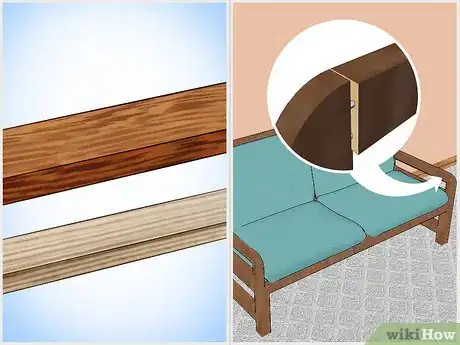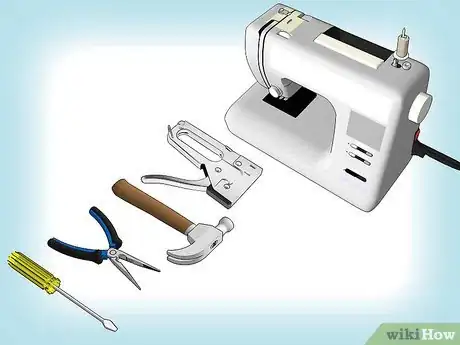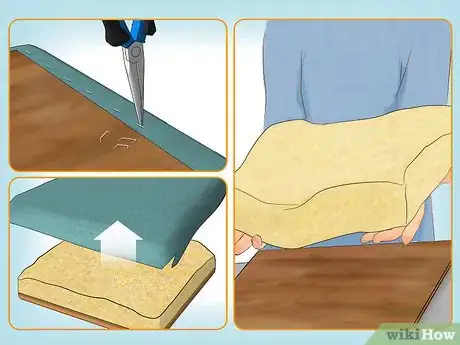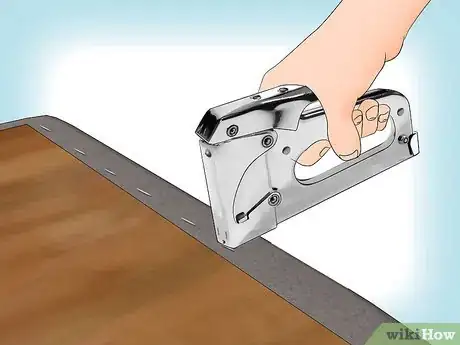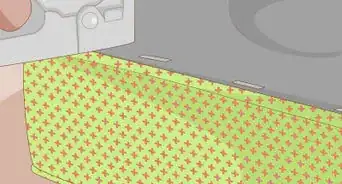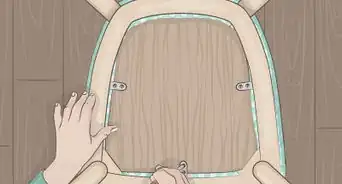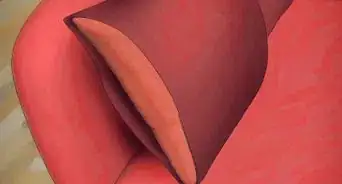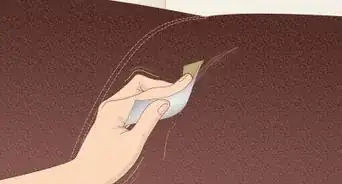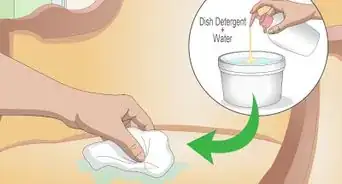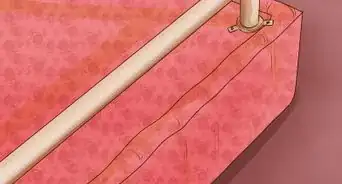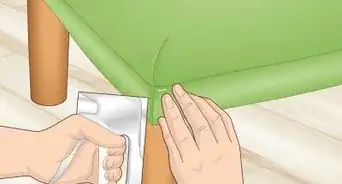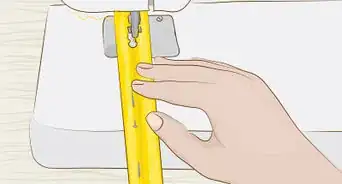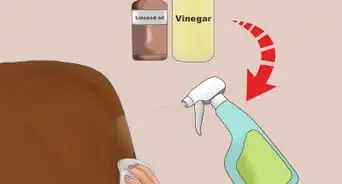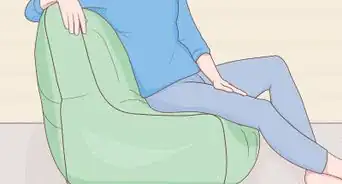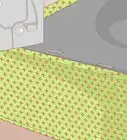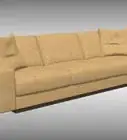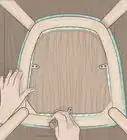This article was co-authored by Katherine Tlapa. Katherine Tlapa is an interior designer, currently working as a Design Specialist for Modsy, a design service based in San Francisco. She also runs her own DIY Home Design blog, My Eclectic Grace. She received her BFA in Interior Architecture from Ohio University in 2016.
There are 15 references cited in this article, which can be found at the bottom of the page.
This article has been viewed 237,459 times.
Whether you have a well-loved piece of furniture at home with upholstery in bad shape, or you've got a thrift piece of furniture for a great price but not-so-great style, you can completely change the look up your furniture through reupholstering.[1] Although the process can be time-consuming, reupholstering furniture at home can save hundreds (or thousands!) of dollars and give you a piece completely unique to your own style and home.
Steps
Preparing for Upholstering
-
1Choose a quality piece of furniture. Reupholstering a piece of furniture is an extensive and time-intensive process. If you attempt to do so on a piece of furniture that is poor quality, you'll experience two things: increased difficulty with the process, and an increased likelihood that the furniture won't last long (making your time/money investment pointless). Start out on the right foot by selecting furniture that is high quality with an ugly 'skin'.[2]
- Look for furniture that is made of solid wood, not veneer or plywood. Solid wood will maintain its value and last a very long time, while veneers and plywood furniture aren't quality enough to last very long.
- Check the furniture for any squeaks, noises, or imbalances. Move the furniture around a bit - if it wobbles or makes noises when you do, it's not in fantastic shape and probably isn't worth reupholstering.
- Look at the overall construction to determine if there is any major damage or problem areas. Nails/screws that are sticking out or missing, broken boards/pieces, or sagging areas may be a sign that the furniture will require more work to fix up than you want to put into it.
-
2Get plenty of quality upholstering fabric. Although you can technically reupholster furniture with any kind of fabric, most fabrics won't be thick and sturdy enough to last for many years. Look for special upholstering fabric, which is thicker and made to stand against wear-and-tear better than other types of fabric. Keep in mind that the type of furniture you use will depend on the placement of the piece; you can get away with using regular fabric on a piece of furniture that won't be frequently used, but you'll definitely need upholstering fabric for pieces that are used often (like a couch).[3]
- Because reupholstering is such a time-consuming process, try to select a fabric that is relatively neutral and will stand the test of time in terms of style. That way, it will fit with your interior design preferences for more time than a bold or trendy fabric choice would.
- If you get a patterned fabric, try to choose one that won't require you to match specific sections of the pattern (like wallpaper) when you cut it into sections. You can still use a cut-specific pattern like this, but it will take much more time trying to lay the pattern out so that each piece is going the same direction as all the other pieces.[4]
Advertisement -
3Get all your tools ready. There aren't any special tools required in reupholstering furniture, but you will need some for the job. Get these in advance to make work easier. You will need:[5]
- A flat-head screwdriver (or a butter knife - this will be for prying)
- Pliers
- A hammer
- A staple gun with staples (the length of the necessary staples will depend on how thick the fabric you're using is)
- Sewing machine with associated supplies.
-
4Prepare extra/optional supplies. You may not need the following supplies depending on your specific project, but they may come in handy for certain reupholstering projects. Scan through the list and see if any might be applicable for the piece of furniture you're working on:
- Cleaning supplies (specifically for old couches)
- Fabric piping for seams/edges[6]
- Cotton batting for added padding
- Buttons (with upholstery needle and thread)
- Cushion zippers
- Replacement feet/legs
Reupholstering Your Furniture
-
1Remove the current fabric from your furniture.[7] Work slowly and meticulously to remove the fabric from your furniture by pulling out all the staples/tacks/screws that are holding it in place. Use your flat-head screwdriver or butter knife to carefully pull out every staple. Do not cut any of the fabric to remove it, as you will be using the pre-existing fabric as your pattern for the new upholstering fabric.
- If you're removing fabric from a couch, you'll need to flip it over and take the fabric off the bottom and back as well.
- Remove any cushions that might be there, but if they don't have a zipper, you might be able to make a cover for them rather than removing all the current fabric.
- Side panels of fabric (like on a sofa) may not require fabric removal, because often you can tack your new fabric over the top.
- Be careful not to cut yourself on the staples or tacks, as these are a very real tetanus threat.
-
2Clean the furniture.[8] Removing the old fabric often exposes the dirty underside of your used furniture; it is best to clean up any messes or dirty areas prior to adding new furniture over the top. For couches, vacuum out the inside of the frame, and spray fabric cleaner onto the cushions and foam to freshen them up. Use a bit of wood oil or cleaner to prepare the wood parts of your furniture, and seal it if necessary.
-
3Measure and cut your new fabric. Lay out all the fabric you removed from you furniture, making sure that you know which piece goes where (or where it went originally). Layer your new upholstery fabric out, and trace the old fabric shapes onto the new. This will serve as your pattern, and allow you to cut out all the necessary pieces for your project. Once you've gotten all the pieces measured/traced, you can very carefully cut out each section, making sure that you mark or keep track of where on the furniture it will be put.
- Use fabric shears for cutting your fabric, in order to make smooth, clean cuts.
-
4Sew the fabric where necessary. Not all of the fabric you upholster will require sewing, in fact typically only cushion and arm covers or pieces of fabric with corners will require any sewing. Use the original fabric as your pattern, and mimic the same sewing pattern with your new fabric. #*Use a thread that will match the fabric, or use a clear plastic thread.
- If you're able, use a serger along the edges to prevent the fabric from fraying.
-
5Staple your new fabric to the furniture.[12] Work one section at a time, lining up your new fabric with its corresponding location on the furniture. Use your staple gun with staples of the appropriate length to attach the fabric securely to the furniture. Make sure there are no gaps, and fold/tuck the edges of each piece of fabric to give it a smooth finish.[13]
- If you need to apply extra layers of batting or cushion, do so prior to re-attaching the fabric.
- Some fabric will have to be attached using upholstery tacks, but you'll know this based on how the original fabric was attached.
-
6Add any finishing touches. When all the fabric has been re-attached to your furniture, you should sew on any piping, buttons, or attach the feet/legs to the bottom of your furniture. This is your chance to make any last-minute changes or to add design details that might not have been on the original piece of furniture. If you decide you're completely finished, give your piece of furniture a once-over to verify that there are no loose threads so-to-speak, and that it's ready to be placed as a permanent fixture in your home.[14]
Expert Q&A
Did you know you can get expert answers for this article?
Unlock expert answers by supporting wikiHow
-
QuestionHow do you reupholster a chair?
 Katherine TlapaKatherine Tlapa is an interior designer, currently working as a Design Specialist for Modsy, a design service based in San Francisco. She also runs her own DIY Home Design blog, My Eclectic Grace. She received her BFA in Interior Architecture from Ohio University in 2016.
Katherine TlapaKatherine Tlapa is an interior designer, currently working as a Design Specialist for Modsy, a design service based in San Francisco. She also runs her own DIY Home Design blog, My Eclectic Grace. She received her BFA in Interior Architecture from Ohio University in 2016.
Interior Designer When reupholstering a chair, you'll first need to disassemble the cushion or the upholstered parts. Some chairs have seats that can be screwed right off, and some are attached. If the padding is in good condition, you can cover the seat easily with new fabric using either upholster glue or staples. If you cannot dislodge the upholstered area of a chair, you have to neatly tuck the fabric around the edges and add something that will conceal the seams. Either roping or fabric beading will work.
When reupholstering a chair, you'll first need to disassemble the cushion or the upholstered parts. Some chairs have seats that can be screwed right off, and some are attached. If the padding is in good condition, you can cover the seat easily with new fabric using either upholster glue or staples. If you cannot dislodge the upholstered area of a chair, you have to neatly tuck the fabric around the edges and add something that will conceal the seams. Either roping or fabric beading will work. -
QuestionHow do I reupholster my headboard?
 DonaganTop AnswererPull the headboard away from the wall, and remove the fabric carefully, using a knife, screwdriver, pliers, or a seam knife. Remove and store any padding. Use the fabric as a "pattern" for the new material. Reinstall any padding, and position the new material, attaching it the way the old material was attached. If decorative tacks were used, you may need to replace them with new tacks.
DonaganTop AnswererPull the headboard away from the wall, and remove the fabric carefully, using a knife, screwdriver, pliers, or a seam knife. Remove and store any padding. Use the fabric as a "pattern" for the new material. Reinstall any padding, and position the new material, attaching it the way the old material was attached. If decorative tacks were used, you may need to replace them with new tacks. -
QuestionHow do I reupholster tractor seats?
 DonaganTop AnswererCarefully remove the fabric (or leather). Save the cushion or padding. Use the fabric as a pattern for cutting out new fabric. Machine- or hand-sew the new cover and stuff it with the old (or new) padding or cushion. Reinstall.
DonaganTop AnswererCarefully remove the fabric (or leather). Save the cushion or padding. Use the fabric as a pattern for cutting out new fabric. Machine- or hand-sew the new cover and stuff it with the old (or new) padding or cushion. Reinstall.
Warnings
- Always use professional tools! Sharp upholstery scissors are essential!⧼thumbs_response⧽
- When stapling, make sure the pattern of the fabric, if any, is aligned straight.⧼thumbs_response⧽
- As an amateur upholsterer, don't try to work with suede or leather. This thick material is very difficult to work with.⧼thumbs_response⧽
- Hire a professional if you are dealing with a vintage, quality piece of furniture.⧼thumbs_response⧽
References
- ↑ Katherine Tlapa. Interior Designer. Expert Interview. 22 May 2019.
- ↑ https://www.forbes.com/sites/moneybuilder/2012/06/27/how-to-buy-quality-furniture/#6ac9018e759b
- ↑ http://www.motherearthnews.com/diy/how-to-reupholster-furniture-zmaz74ndzraw.aspx?PageId=2#ArticleContent
- ↑ http://www.bhg.com/decorating/do-it-yourself/fabric-paper-projects/what-you-need-to-know-before-you-reupholster/
- ↑ https://www.allthingsthrifty.com/10-essential-tools-needed-for-upholstery/
- ↑ Katherine Tlapa. Interior Designer. Expert Interview. 22 May 2019.
- ↑ Katherine Tlapa. Interior Designer. Expert Interview. 22 May 2019.
- ↑ https://www.familyhandyman.com/cleaning/how-to-clean-furniture-and-fight-odors-without-chemical-cleaners/
- ↑ https://www.todayshomeowner.com/video/how-to-repair-scratches-on-wood-cabinets-and-furniture/
- ↑ https://www.bobvila.com/articles/30124-dream-it-do-it-how-to-paint-wood-furniture/
- ↑ https://www.bobvila.com/articles/44273-how-to-stain-wood-furniture/
- ↑ https://www.apartmenttherapy.com/cheap-ways-to-reupholster-furniture-261782
- ↑ Katherine Tlapa. Interior Designer. Expert Interview. 22 May 2019.
- ↑ http://www.allthingsthrifty.com/2009/11/reupholstering-101-how-to-reupholster.html
- ↑ https://www.designsponge.com/2011/07/upholstery-basics-dining-chair-do-over.html
- https://lifehacker.com/how-to-reupholster-an-old-piece-of-furniture-1722178803
- https://www.bhg.com/decorating/do-it-yourself/fabric-paper-projects/diy-chair-upholstery-guide/
- https://www.familyhandyman.com/woodworking/furniture-repair/how-to-reupholster-a-chair/
About This Article
To reupholster furniture, start by removing the old fabric by pulling out the staples or tacks holding it to the frame. Once you’ve taken off the old fabric, use the pieces as a pattern to cut out pieces from the new fabric. Next, sew the new fabric along the seams using the old pieces as a guide to help you know where to put your stitches. Then, place the fabric over its corresponding location on the furniture, making sure to line up the seams correctly. Finally, pull the fabric taut and use a staple gun to secure it to the underside of the furniture. For tips on how to add finishing touches, like piping or buttons, to your reupholstered furniture, read on!

